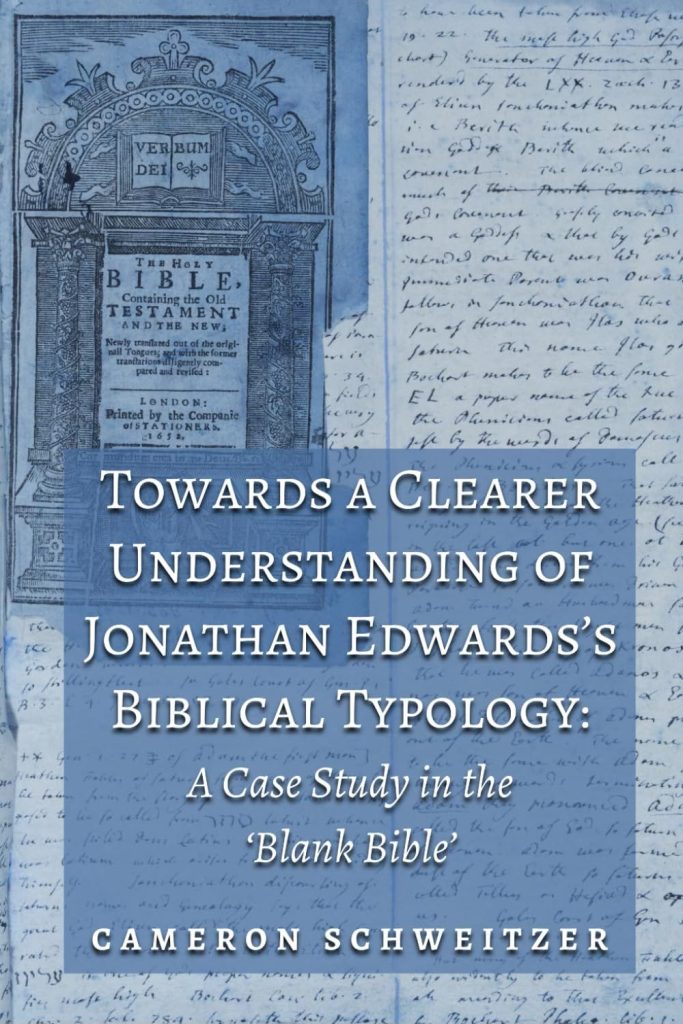Jonathan Edwards, one of the most profound theological minds of the 18th century, left an unparalleled legacy in the realm of biblical exegesis. Yet, an often-overlooked dimension of his work is his extensive use of biblical typology. In Towards a Clearer Understanding of Jonathan Edwards’s Biblical Typology: A Case Study in the ‘Blank Bible’, Schweitzer invites readers into an illuminating exploration of Edwards’s typological framework, challenging long-held scholarly interpretations that narrowly define it as either “conservative” or exclusively “Christological.”
The following excerpt comes from the foreword of Dr. Schweitzer’s book.
The Study’s Thesis, Uniqueness, and Methodology
Thesis
Scholars clearly disagree over both the nature of Edwards’s biblical typology and how to describe it. There is a need, therefore, to consider additional evidence to adjudicate between these competing interpretations. The present project will do this through an inductive examination of Edwards’s Blank Bible. The study’s thesis is two-fold. This project will argue, first, that those in the “Miller-Lowance line” who have either explicitly stated or implied that Edwards’s biblical typology is “conservative”—on either the “looser” or “tighter” definitions of the term have not sufficiently considered all of the available evidence.1 The evidence unearthed from the Blank Bible, therefore, will strongly suggest that Sweeney, Nichols, Brown, and others are perhaps right to recognize that one should not call Edwards’s biblical typology “conservative.”
This project will argue, second, that the Blank Bible‘s typological notations underscore that one cannot accurately summarize Edwards’s biblical typology as “wholly Christological” or as a “Christological typology” either. That is to say, this study will contend that Edwards’s employment of exegetical typology in his Blank Bible strongly suggests that it is less-than-precise to characterize his biblical typology as either “conservative” or “Christological.” Thus, a reconsideration and recategorization of his exegetical typology is in order.
The evidence to follow will suggest that Edwards’s typological notes in the “Interleaved Bible” are too diverse in their assignment of antitypes, as well as the manner and time in which he asserts that types find fulfillment, to refer to his exegetical typology as “conservative” or “wholly Christological.” Thus, to borrow the terms of the “Miller-Lowance line,” Edwards “broadens” the “nomenclature” of “orthodox typology” not only when speaking of types in secular history and nature, but also in biblical exegesis.2
In the Blank Bible, in view of the “tight” and “loose” definitions of “conservative” typology provided by Miller, Lowance, and their followers, Edwards uses “conventional” biblical-typological language in five, “broadened” ways. (1) He does so by asserting that not only are the Old Testament’s significant persons, events, and institutions typical, but so are its seemingly insignificant minutia. (2) Edwards does this as he connects type and antitype within the Old Testament itself. (3) He does so when he speaks of Old Testament types pointing towards non-Christological antitypes. (4) This is evidenced when he connects historical types to ahistorical antitypes that embody theological/spiritual principles. (5) Edwards uses this “conservative” language in a new manner as he typologically interprets events in the New Testament as harbingers of still future realities. The present study intends to make clear that authors should replace the imprecise term “Christological,” as well as the inaccurate terms “liberal” and “conservative,” with more accurate, and less-semantically loaded terms to describe Edwards’s biblical typology.
The present study intends to make clear that authors should replace the imprecise term “Christological,” as well as the inaccurate terms “liberal” and “conservative,” with more accurate, and less-semantically loaded terms to describe Edwards’s biblical typology.
The project’s inductive analysis will suggest two other conclusions that are particularly important to ongoing, broader discussions of Edwards’s exegesis and typology. (1) As it pertains to his exegesis broadly, this project will underscore that Edwards’s exegesis is not “imaginative” or “unconstrained”—as Stephen Stein has argued.3 The evidence will suggest that this label is unfair, because, in agreement with what other authors have cogently documented, Edwards’s exegesis has hermeneutical restraints.4 In concurrence with these authors, the evidence to follow will highlight that Edwards notably employs the “rule of faith,” the “rule of scripture,” and a “whole Bible” redemptive-historical hermeneutic to keep his interpretations from heterodoxy and confined within biblically acceptable boundaries. The data should highlight that Edwards theologizes and typologizes only to the extent that he believes the Bible’s language or theology reasonably warrants it.5
(2) As it applies to his exegetical typology in particular, this project will also contend that those authors who ultimately root Edwards’s typology and its unity in his Lockean philosophy, aesthetics, or understanding of the “new physics” are not entirely correct either.6 Rather, as others have argued, it is more appropriate to interpret Edwards’s typological system as the overflow of his biblical exegesis and theology.7
The Project’s Contributions
This project intends to makes five unique contributions to Edwards scholarship. (1) This study will provide a new monograph-length study of Edwards’s Blank Bible—a document which itself has attracted but a few extended treatments.8 It is for good reason, then, that Robert Brown has said that “the immense amount of material” in Edwards’s Blank Bible “has hardly been tapped.9 To date, other than the work the current author has contributed, there have been only five focused treatments of Edwards’s longest exegetical notebook.10
(2) This study will pursue this end through a prolonged, inductive analysis of all the Blank Bible‘s relevant typological notations. This is in comparison to simply providing only a few examples of his exegesis or making generalized statements about his typological exegesis without detailed argumentation. Such a methodological choice allows the reader to see for themselves what Edwards says about the typological meaning of biblical texts, as well as how and why he says it.
(3) This project will argue that writers cannot accurately label Edwards’s exegetical typology as “conservative,” like the “Miller-Lowance line” contends. Furthermore, the evidence will underscore that his exegetical typology cannot be categorized as “Christological” either. No work has yet advanced this two-fold thesis. Only a handful of writers have pointed out either one or the other—usually in passing—but not while explicitly advocating both.
(4) Via its inductive analysis, this project will also contend that, contrary to Stephen Stein, Edwards’s exegesis is not “unprincipled” or “unconstrained,” but rather that he employs the “rule of faith,” the “analogy of scripture,” and his “typological warrant” to guide, inform, and constrain his exegesis. (5) The present work will also assert that one will best understand Edwards’s typological system as a unifed whole, which he knits together with his biblical exegesis and theology.
The Project’s Methodology
There are four important components of this study’s methodology. (1) The project will focus on Edwards’s Blank Bible. At times, though, this profect may analyze Edwards’s exegetical reflections found in other parts of his corpus. Such analysis will occur when Edwards refers to such reflections within the Blank Bible; or, when Edwards’s thoughts elsewhere provide critical insight into his thinking. Footnotes will also direct the reader to other places of the Works of Jonathan Edwards where Edwards mentions the same scriptural text to which he appends a particular Blank Bible note. These footnotes will primarily serve a referential function, but, they will provide greater analysis when Edwards mentions/discusses typology while speaking of the same biblical text as the note in the “Interleaved Bible.”
(2) This study will focus exclusively on those notes in the Blank Bible where Edwards explicitly uses words from the “type” family (i.e., type, types, typify, typifies, etc.) to make a figural-theological connection between the biblical text (sign) and that to which it points (signification). One can reasonably argue that it makes the most sense to examine those notations wherein Edwards explicitly employs the word “type”—or one of its derivatives—to make a figural connection between a sign and its signification. Since Edwards, by using this language, is clearly stating that he believes such texts convey “typological” meaning.
This focus does not imply, however, that one cannot similarly understand Edwards’s other favored, “figural-connecting words” as further examples of Edwards’s typological thinking, or that these notations are unimportant when investigating Edwards’s typological exegesis. These “connecting words” include “represent(s),” “signify(ies).” “denote(s),” earnest,” and “image(s).” or his immediate-figural comparisons in which he uses “so,” “as,” or “thus.” But, simply for the sake of focus, this work will limit itself to notations that explicitly use words from the “type” family.
To examine notations that employ one of his other “connecting words” demands that one argues for Edwards’s conscious, synonymous use, and free-interchange of such words with “type” and its derivatives. This is not a step that one can make without justification. While one may synonymously understand his other “connecting words” with “type(s),” they are not explicitly synonymous in-and-of-themselves. Given that these “connecting words” are not explicit derivatives of “type(s).”11
Lisanne Winslow helpfully points out that “many terms have synonymously been used” among authors regarding Edwards’s typology, but they have done so “randomly, interchangeably, and often incorrectly” when speaking of God’s typological communication. Winslow points out that this has proven harmful since not all of Edwards’s figural-connecting words can “correctly be subsumed in the category of types,” because tropes are not types, and types are not tropes. Therefore, “scholarship in this area needs to be more precise.”12
Having said this, however, there is evidence to suggest that Edwards may use his other “connecting words” synonymously with “type(s).” For example, there are cases in the Blank Bible where he freely interchanges these words with “type” and its derivatives when discussing a text’s forward-leaning, anticipatory significance. See, for instance, his notes on Gen 3:7–8; Genesis 4; Gen 7:1; Exo 24:1–11; Lev 14:34; and Num 21:18. In these notes, he interchanges “type” with “represents” as he unfolds the text’s prefigurative, redemptive-historical significance.13
Speaking of the phrase the “word of the LORD” in Zech 4:6 and 11:1 in Notes on Scripture, Edwards shows the ease with which he can interchange “sign” and “type.” He says
“Now types are a sort of word; they are language, or signs of things, God would reveal, point forth, and teach as well as vocal or written words, and they are called ‘the word of the Lord,’ in Zechariah 4:6, and Zechariah 11:11. And thus also the word of the Lord came to the princes of Israel, i.e. that state and those circumstances came to ’em, and were ordered to ’em, that were typical of the Son of God, and were as it were God’s word, signifying the dignity and office of the Messiah. Such divine significations, when persons were made the inherent subjects of them, were generally of the Son of God, the eternal personal Word. And therefore when such a typification happened, or was ordered to a person, or any person became the inherent subject of such a divine signification, then the word of God was said to come to him. It was the signification or typification (if I may so speak), was the word of God, both as it was God’s signification, and also as the thing signified was the personal Word of God.14
Edwards’s practice implies, therefore, that one could consider those notations which make sign/signification connections with his other figural-connecting words in a study on Edwards’s exegetical typology. To do so at present, however, would unduly lengthen this study—given the frequency with which Edwards uses these other connecting words.
This project’s focus on words in the “type-family” narrows the study to a reasonable scope. Furthermore, since Edwards nowhere—at least from what this author has uncovered—explicitly states that his other “connecting words” are synonymous with “type” and its derivatives, it seems wiser to focus on those notations that explicitly use words from the “type-family” when examining Edwards typological exegesis in the Blank Bible. With this focus, the interpreter has reasonable assurance that Edwards was interpreting given text typologically.
(3) This project will inductively examine all the relevant Blank Bible notes in which Edwards employs a word from the “type-family.” Given such linguistic constraints, the present research has uncovered 210 different notations in the “Interleaved Bible” wherein Edwards uses a “type” word to connect a redemptive-historical sign with its signification.15
This project has grouped these 210 notations into fourteen distinct, “antitypical categories.” These include redemption and redemptive history, Christ’s person, Christ’s work, the Church, intra-Old Testament connections, intra-New Testament connections, eschatology, the world, spirituality, the sacraments, Christian ministry/ministers, Satan/demons, sin, and the Holy Spirit. This study will examine each of these notes one-by-one in order to determine what Edwards says about the typological connection, how he makes the connection, and why he connects the type and antitype. Moving in this slow, methodical manner allows the reader both to see and understand Edwards’s typological interpretation at work.16 That being said, the study will not detail all of Edwards’s typological notations in the “Interleaved Bible.” Since Edwards often speaks repetitiously of certain type-antitype relationships, which lends itself to one’s grouping such notes together to avoid unnecessary redundancy. This close, text-by-text examination, though, will support and inform all that this projects says, even as it summarily binds together notes that make similar/identical typological comments.
(4) This study is also synchronic in nature. That is, this project will not develop a diachronic argument for how Edwards’s typological exegesis may or may not have developed over the three decades he compiled his notes in this notebook.17 The reason being, in the words of the Blank Bible‘s editor, Stephen Stein, it is “a chronological puzzle” that will likely only ever be “partially solved.” Further, Stein comments that chronological data or development on the various entries of this notebook “are not necessary for reading, understanding, appreciating, or using this book.”18 This project, therefore, because of its limited focus, will also not enter into the debate regarding the possibility of development in Edwards’s typology over time.19 Rather, this study will view all of the relevant typological notations as each having an equal and significant witness to Edwards’s practice and understanding of exegetical typology.
- The “looser” definition of biblical typology refers to those of this scholarly school who define this interpretive practice as one’s connecting an Old Testament type with a New Testament antitype. While those who give a “tighter” definition of this exegetical practice define it as an interpreter’s connecting an Old Testament type with a Christological antitype. ↩︎
- Lowance and Watters, “Editor’s Introduction,” WJE 11:178. ↩︎
- For those who contend that the Bible did not function for Edwards “as a theological norm or source in any usual Protestant fashion,” see Stein, “The Quest for the Spiritual Sense,” 113. idem. “Jonathan Edwards and the Rainbow” 453; idem., “Editor’s Introduction,” WJE 24.823 Also, Stephen Nichols who, in light of what he says elsewhere, confusingly quotes Stein with approval in “Jonathan Edwards’s Principles of Interpreting Scripture,” in Jonathan Edwards & Scripture, 48. In the same volume, Chamberlain does the same thing in her essay “A Fish Tale,” 162. With different language but a similar intent, Michael Clark speaks similarly in “The Eschatology of Signs,” 433. William Ward also states that Edwards’s exegesis is “complete severed from the literal sense.” Ward, Early Evangelicalism: A Global Intellectual History, 1670-1789 (Cambridge University Press, 2006): 146. ↩︎
- Barshinger, “‘The Only Rule of Our Faith and Practice’: Jonathan Edwards’s Interpretation of the Book of Isaiah as a Case Study of His Exegetical Boundaries,” Journal of the Evangelical Theological Society 52 (December 2009): 811–829, 812–13; idem. Edwards and the Psalms, 366; Ayabe, “A Search for Meaning,” 15, 105; Adrian Neele, “Early Modern Biblical Commentary and Jonathan Edwards,” in Jonathan Edwards & Scripture: 51–67, 67; Ted Rivera, “Jonathan Edwards’s Hermeneutic: A Case Study of the Sermon ‘Christian Knowledge,'” Journal of the Evangelical Theological Society, 49, no. 2 (June 2006): 273–286, 286; Andrew Abernathy, “Jonathan Edwards as Multi-Dimension Bible Interpreter, A Case Study from Isaiah 40–55,” Journal of the Evangelical Theological Society 56 (December 2013): 815–830, 825–826; Sweeney, Edwards the Exegete, 70–4; John Gerstner, “Jonathan Edwards and the Bible,” in Inerrancy and the Church, ed. John Hannah (Chicago: Moody Press, 1984): 257–278, 276. ↩︎
- The latter of these two, especially as it applies to his typological reflections, is embodied in Edwards’s principle of “typological warrant” codified in his “Types” notebook. Speaking of this typological interpretive-principle, he states that “persons ought to be exceedingly careful in interpreting of types, that they don’t give way to a wild fancy; not to fix an interpretation unless warranted by some hint in the New Testament of its being the true interpretation, or a lively figure and representation contained or warranted by an analogy to other types that we interpret on sure grounds” (WJE 11:148). ↩︎
- Miller, “Introduction,” 23–25; Knight, “Learning the Language of God,” 549; Anderson,
“Editor’s Introduction,” WJE 11:9, 13, 23; Winslow, A Great and Remarkable Analogy, 42–53;
Nichols, Jonathan Edwards’s Bible, 69–77; Zakai, “Theological Origins,” 722; Ward, Early Evangelicalism, 145. ↩︎ - Butler, “God’s Visible Glory,” 18–19; Kloosterman, “The Use of Typology,” 77; Kimnach,
“Editor’s Introduction,” WJE 10:132; Kenneth Minkema, “Editor’s Introduction,” WJE 14:31–32;
Ayabe, “A Search for Meaning,” 98–99, 113; Plantinga-Pauw, The Supreme Harmony of All,
37–38; Boss, God Haunted World, 106; McDermott, Everyday Glory, 11, 54–55. See also my two essays “‘See Notes On’: The Blank Bible‘s Contribution to Edwards’s Images or Shadows of Divine Things,” and “How Scripture Justifies Jonathan Edwards’s Typological View of the Old Testament: A Reconsideration of the ‘Types’ Notebook,” in The Jonathan Edwards Miscellanies Companion: Volume 2, ed. Rob Boss and Sarah Boss (Dallas: JESociety Press, 2021). Ryan Hoselton provides a helpful survey of the debate about Edwards’s primary dependence upon either the Bible or John Locke. He argues that the Bible had a greater influence on Edwards’s thinking than Locke. Hoselton, “Spiritually Discerned: Cotton Mather, Jonathan Edwards, and Experiential Exegesis in Early Evangelicalism” (PhD diss., Ruprecht-Karls-Universitat Heidelberg, 2019), 91 ftn. 2. ↩︎ - This is despite the fact that Kenneth Minkema and Wilson Kimnach have pointed out that the Blank Bible served as his study’s critical “center,” and was one of his most beloved notebooks. Kimnach and Minkema, “The Material and Social Practices of Intellectual Work: Jonathan Edwards’s Study,” William and Mary Quarterly 69, no. 4 (Oct. 2012), 683–730, 713. ↩︎
- Brown, “The Bible,” 98. ↩︎
- For a survey of these works, as well as some of my own, consult appendix A. These five treatments are: Francis White, “The Reformation Roots and Edwardsean Fruits of the Missiology of Jonathan Edwards’s Interleaved Bible” (ThM thesis, Westminster Theological Seminary, Philadelphia, 1991); Stein, “Editor’s Introduction,” WJE 24:1–117; idem., “Cotton Mather and Jonathan Edwards on the Epistle of James: A Comparative Study,” in Cotton Mather and Biblia Americana — America’s First Bible Commentary: Essays in Reappraisal, ed. Reiner Smolinski and Jan Stievermann (Tübingen: Mohr Siebeck, 2010): 363–382; Wayman, “Women as Types;” Landrum, Edwards’s Exegesis of Genesis. For brief, book reviews of the Blank Bible, see Robert Caldwell, “The ‘Blank Bible.'” Southwestern Journal of Theology 52, no 2 (2010): 166–171; and Richard Bailey, “The ‘Blank Bible,” Fides Et Historia 39, no 2 (September 2007): 144–146. ↩︎
- For an author who makes an argument for the synonymous use of these terms, see Boss, God-Haunted World, 106, 108. Tibor Fabiny also recognizes Edwards’s interchange of these terms. See his “Edwards and Biblical Typology,” 99. Gerald McDermott does the same in his Edwards Confronts the gods, 111 ftn. 3. For authors who unjustifiably equate these terms, see Wayman, “Women as Types,” 66, 68–69, 74; Beuttler, “Critical Assaults on the Bible,” 159–161; Gilsun Ryu, “The Federal Theology and the History of Redemption in Jonathan Edwards’s Biblical Exegesis,” Journal of the Evangelical Theological Society, 61.4 (Dec. 2018): 785–803, 800–801; Landrum, Edwards’s Exegesis of Genesis, 97–102. In Landrum’s case this lack of semantic-categorical clarity undermines his charge that Edwards’s “inferred typology” is “liberal.” Since, in several instances, Landrum speaks of Edwards’s “typological” interpretation as evidenced in particular notes, when the note to which he appeals uses one of Edwards’s other “connecting-words.” These instances are the ones in which Landrum usually argues that Edwards did not use “acceptable, antitypical options.” On these notes’ faces, therefore, without Landrum arguing for Edwards’s synonymous use of such terms with “type(s),” he does not have the grounds to assert that Edwards is not typologically interpreting. Rather, one could argue that Edwards is there interpreting allegorically, moralistically, or principalistically. So when Landrum claims that Edwards’s typological hermeneutic is “unacceptable,” he charges Edwards with a crime of which he has not yet proven him guilty. ↩︎
- Winslow, A Great and Remarkable Analogy, 82–83, 87–88. Wilson Kimnach makes a similar point when he observes that “Edwards carefully differentiated ‘image’ from ‘shadow’ with their different connotations.” Kimnach, “Editor’s introduction,” WJE 10:234–235. Edwards makes his case for the separation of these terms from Hebrews 10:1 (“the law having a shadow of good things to come, and not the very image of the things”). Writing to himself in Notes on Scripture, he asserts “here a shadow is distinguished from images or pictures, as being a more imperfect representation of the things represented by it. The types of Old Testament are compared to this kind of representations of things, not only here, but Hebrews 8:5 and Colossians 2:17 . . . The shadow of a thing is an exceedingly imperfect representation of it, and yet has such a resemblance that it has a most evident relation to the thing, of which it is the shadow. Again, shadows are dark resemblances; thought there be a resemblance, yet the image is accompanied with darkness, or hiding of the light. The light is beyond the substance, so that it is hid. So was it with the types of the Old Testament; they were obscure and dark. The light was beyond the substance; the light that was plainly to reveal gospel things came after Christ” (WJE 15:247–248). For a similar comment, see Edwards’s Blank Bible note on Heb. 1:3 (WJE 24:1137). ↩︎
- The tables at the end of this volume will provide the places where Edwards employs these other “connecting words” while discussing his type-antitype pairs. ↩︎
- WJE 15:580 ↩︎
- Stephen Stein, the Blank Bible‘s editor, estimates that there are about 5,500 different notes in the notebook. This means that Edwards’s explicit typological notations account for about 4 percent of its total notations. If one were to add to this all those other notes in which Edwards uses words like “represents” or “signifies,” this percentage more than doubles. This underscores two things. First, figurative interpretation plays an important, minor role in his exegesis, Second, these percentages also underscore, therefore, that Edwards primarily engaged in grammatical-historical exegesis in his “Interleaved Bible.” Stein, “Editor’s Introduction,” WJE 24:1–2 ↩︎
- Wayman’s study (“Women as Types”) underscores the importance of moving in this methodic manner to investigate Edwards’s exegetical typology. His study showed that simple word
searches overlook pertinent examples. See the fifth chapter for treatment of this issue. ↩︎ - For a diachronic treatment of Edwards’s growing exegetical awareness, see Withrow, “‘Full of Wondrous and Glorious Things.'” Contrary to certain scholars in the Miller-Lowance school who contend that Edwards gradually shifted from his early focus on typological exegesis to a later focus on nature typology, Edwards’s exegetical notebooks highlight that he engaged in typological exegesis into his life’s last years. Wallace Anderson makes this point when he dates Edwards’s “Types” notebook—which is Edwards’s biblical defense of his typological-exegetical schema’s legitimacy—to the middle or late 1740s. Given that “Types” dates so late in Edwards’s life, therefore, contrary to the arguments of authors like Thomas Davies, this underscores both that Edwards had not “abandoned” traditional biblical typology in favor of his “more expansive system” of “Platonic” musings, and that Edwards continued to engage in biblical typology late into his life. Davis, “The Traditions of Puritan Typology,” 377. ↩︎
- Stein, “Editor’s Introduction,” WJE 24:2, 102. Two pages later, Stein makes the following point about the Blank Bible‘s editorial dating as compared to other critical editions in the Works of Jonathan Edwards. He says that “dating more than five thousand entries written randomly in the interleaved Bible in scattered fashion over a period of nearly three decades represents a scholarly challenge of a wholly different magnitude. The ‘Blank Bible’ is an editor’s nightmare.” ↩︎
- For a few authors that discuss the possibility of typological development, see Ayabe, “A Search for Meaning,” 95–96; Lowance, “Jonathan Edwards and the Platonists,” 130–131; idem., “‘Images or Shadows of Divine Things’ in the Thought of Jonathan Edwards,” 211, 215, 222, 241; idem., “Images or Shadows of Divine Things: The Typology of Jonathan Edwards,” Early American Literature 5, no. 1 (Spring 1970): 141–181, 143, 147. ↩︎

Towards a Clearer Understanding of Jonathan Edwards’s Biblical Typology: A Case Study in the ‘Blank Bible’ is available for purchase.

Owning Up to the Failures of our Theological Heroes
What can be done when you discover the sins of historical figures who have shaped your theology?

Jonathan Edwards and the Asbury Revival
Chris Chun and Chris Woznicki discuss the signs of true revival, signs of the work of the Holy Spirit, and why it is important to critically assess the characteristics of revival in a spirit of charity.

Jonathan Edwards and the Baptists | Douglas Sweeney, Nathan Finn and Chris Chun
Dr. Douglas Sweeney and Dr. Nathan Finn joined Dr. Chris Chun for a panel discussion on Jonathan Edwards, recorded live at the SBC Annual Meeting in Anaheim.



